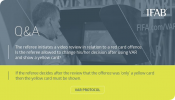He's running into it so there is force there, he lunges in, studs showing, with a straight(ish) leg, and goes entirely over the top of the ball. I think the only reason the Palace didn't get stretchered off with tib & fib snapped in two is because he can see it coming and avoids the worst of the contact.
I think that strengthens the argument that “referees haven’t played the game“, I think he was trying to hook the ball, not endangering the safety an opponent, not enough force for SFP, you could argue reckless.

You are using an out of date browser. It may not display this or other websites correctly.
You should upgrade or use an alternative browser.
You should upgrade or use an alternative browser.
Pal v Eve
- Thread starter Faris
- Start date
That's my point about protecting himself, it is what players were trained to do years ago. There is absolutely no justifiable reason for his right leg to be that high when the ball was on the floor. The more I watch the more clear a red I think it is.He's running into it so there is force there, he lunges in, studs showing, with a straight(ish) leg, and goes entirely over the top of the ball. I think the only reason the Palace didn't get stretchered off with tib & fib snapped in two is because he can see it coming and avoids the worst of the contact.
I don't think they'll win an appeal, if they try one. For the that very reason.That's my point about protecting himself, it is what players were trained to do years ago. There is absolutely no justifiable reason for his right leg to be that high when the ball was on the floor. The more I watch the more clear a red I think it is.
mctones
Member
LOTG quite clear on this, surprised to see people arguing that contact was slight, that doesn’t lower the danger of the action Calvert-Lewin made.
“Any player who lunges at an opponent in challenging for the ball from the front, from the side or from behind using one or both legs, with excessive force or endangers the safety of an opponent is guilty of serious foul play.”
“Any player who lunges at an opponent in challenging for the ball from the front, from the side or from behind using one or both legs, with excessive force or endangers the safety of an opponent is guilty of serious foul play.”
LOTG quite clear on this, surprised to see people arguing that contact was slight, that doesn’t lower the danger of the action Calvert-Lewin made.
“Any player who lunges at an opponent in challenging for the ball from the front, from the side or from behind using one or both legs, with excessive force or endangers the safety of an opponent is guilty of serious foul play.”
It was not excessive force though. I think this is the classic case of the referee didn't see it properly and the VAR got involved with that because if Kavanagh blew for a foul and produced a yellow card, I be shocked if that got overturned.
On a side point, at the monitor, if Chris Kavanagh thinks it's not a red, could he still produce a yellow in this situation or is it red or nothing?
It's probably not excessive force but it does endanger an opponent.It was not excessive force though. I think this is the classic case of the referee didn't see it properly and the VAR got involved with that because if Kavanagh blew for a foul and produced a yellow card, I be shocked if that got overturned.
On a side point, at the monitor, if Chris Kavanagh thinks it's not a red, could he still produce a yellow in this situation or is it red or nothing?
Can't produce anything if he doesn't think it's a red.
Gabriel
Well-Known Member
I think yellow on this one rather than red personally, although I can understand why some would go red. I also can't remember where I saw it, but a while back I saw something that said if the referee watches an incident back in the RRA, if they think an incident is yellow rather than red, this still has to be punished.
Was it good luck or good timing that the raised foot didn't make contact half a second earlier, in the middle of the shin causing a serious injury?
Good timing, then it was a harsh decision.
Good skill, then red.
I think it was luck. I'm happy with red, but this is always a hard one to sell to Joe Public.
(Edited to add an E to the end of "one" so I don't get banned)
Good timing, then it was a harsh decision.
Good skill, then red.
I think it was luck. I'm happy with red, but this is always a hard one to sell to Joe Public.
(Edited to add an E to the end of "one" so I don't get banned)
I'm fairly sure that it can't be because VAR can't be used to issue yellow cardsI think yellow on this one rather than red personally, although I can understand why some would go red. I also can't remember where I saw it, but a while back I saw something that said if the referee watches an incident back in the RRA, if they think an incident is yellow rather than red, this still has to be punished.
ladbroke8745
RefChat Addict
Only seen the clip in this thread via twitter, so can only make comment on what effectively the ref saw on Var.
It does seem like a typical strikers challenge. He does go, stupidly, above the ball, and he does put his weight behind it. May not be his entire weight but enough I think to make the opponent not challenge properly for fear of significant injury.
I could actually argue an "orange" here. If seen real time, could definitely go red; think he's missed it I believe in real time. Also think he could go yellow as reckless.
What gets me, and the reason why I've come on to the page this morning, is Paddy Powers social pages. Love to cause controversy and more pain on referees with their posts.
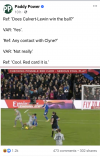
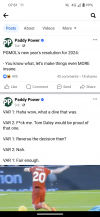

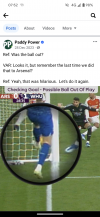

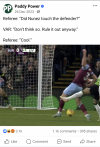
I get it's their page and it "may" bring more people to their page/website, but this does nothing to support refs and makes it much more difficult.
It does seem like a typical strikers challenge. He does go, stupidly, above the ball, and he does put his weight behind it. May not be his entire weight but enough I think to make the opponent not challenge properly for fear of significant injury.
I could actually argue an "orange" here. If seen real time, could definitely go red; think he's missed it I believe in real time. Also think he could go yellow as reckless.
What gets me, and the reason why I've come on to the page this morning, is Paddy Powers social pages. Love to cause controversy and more pain on referees with their posts.






I get it's their page and it "may" bring more people to their page/website, but this does nothing to support refs and makes it much more difficult.
Gabriel
Well-Known Member
They aren't using to 'review' a YC though. Just for a possible RC, so this is slightly different under the lawsI'm fairly sure that it can't be because VAR can't be used to issue yellow cards
Right... And what happens when Palace challenge that as a red card?Not having that as a red, and definitely not having it as a C&O error. Further proof this VAR setup doesn't work.
I'm sure someone mentioned a solution in another thread.....
Same outcome.
2 PGMO officials have looked at it and come up with red card.
Kav could just as easily, as he has done before, carried out OFR and said not red, if he thought it wasn't.
So suggesting that a challenge system fixes this is fairly disingenuous imo.
R
Runner-Ref
Guest
Then onfield referee checks it and makes a decision on their own. No VAR in their ear telling them what they think they have seen.
I don't really buy the '2 PGMO officials have seen it' part. 2 officials saw the incidents I mentioned earlier in Spurs vs Brighton game, yet they were later judged by HW to be incorrect.
2 referees saw the non-award of a pen in the Utd vs Wolves game, but they were still judged to be wrong by HW. So 2 PGMO referees making a decision does not necessarily make it correct.
Will it clear up every single decision? No. Would it maybe help relations between clubs and referees as the clubs are at least getting an input? It's got to be better than it is right now.
Think of the Spurs vs Liverpool game- not a chance we don't get the correct outcome in there's a challenge based system.
Chelsea vs Spurs last season with the hair pull. Chelsea easily challenge that and Spurs are down to 10 men.
So there's at least 2 major errors that have been fixed.
I don't really buy the '2 PGMO officials have seen it' part. 2 officials saw the incidents I mentioned earlier in Spurs vs Brighton game, yet they were later judged by HW to be incorrect.
2 referees saw the non-award of a pen in the Utd vs Wolves game, but they were still judged to be wrong by HW. So 2 PGMO referees making a decision does not necessarily make it correct.
Will it clear up every single decision? No. Would it maybe help relations between clubs and referees as the clubs are at least getting an input? It's got to be better than it is right now.
Think of the Spurs vs Liverpool game- not a chance we don't get the correct outcome in there's a challenge based system.
Chelsea vs Spurs last season with the hair pull. Chelsea easily challenge that and Spurs are down to 10 men.
So there's at least 2 major errors that have been fixed.
Last edited by a moderator:
That's great but as I alluded in that thread, a challenges this system favours the more charismatic, articulate and persuasive managers.Then onfield referee checks it and makes a decision on their own. No VAR in their ear telling them what they think they have seen.
I don't really buy the '2 PGMO officials have seen it' part. 2 officials saw the incidents I mentioned earlier in Spurs vs Brighton game, yet they were later judged by HW to be incorrect.
2 referees saw the non-award of a pen in the Utd vs Wolves game, but they were still judged to be wrong by HW. So 2 PGMO referees making a decision does not necessarily make it correct.
Will it clear up every single decision? No. Would it maybe help relations between clubs and referees as the clubs are at least getting an input? It's got to be better than it is right now.
Think of the Spurs vs Liverpool game- not a chance we don't get the correct outcome in there's a challenge based system.
Chelsea vs Spurs last season with the hair pull. Chelsea easily challenge that and Spurs are down to 10 men.
So there's at least 2 major errors that have been fixed.
You're fixing a handful of errors whilst creating more opportunities for errors as there will be a greater number of interventions/challenges. And borderline ones, where the referee knows declining could have serious impact later on, if he makes a serious error and removes a teams ability to challenge. And if it's left unchallenged you may still have a refereeing error at the end of it. Either way it will come full circle and the same old issues will exist.
Some of the examples you've given aren't really comparable to the argument, or show a lack of understanding of the current VAR protocol.
The Man U V Wolves as an example, the VAR might have thought it was a penalty. But with the training and guidance he had might have thought it didn't meet the threshold for an intervention. That's very different to 2 referees looking at it and coming up with the same answer, as in this one where both have viewed the monitor and agreed upon a red card sanction.
I'm not suggesting it's right and that because 2 PGMO officials have said it was a red that makes it correct, my argument here is that there's a high probability that CK is challenge by Palace and he goes red.
Do the opposing team get to offer a counter argument to the challenge? I highly doubt it..so the referee is still only going to get a one sided view before he views it, and as above, the right sales man delivers the pitch, he gets the sale. But we still potentially have a refereeing error on the end of it.
We may as well do ask the audience as well if that's the way we want to head as they seem to guide what football expects these days.
Feature, not a bug. He's might still think that's red and we're not suddenly magically expecting every single viewer to have the same opinion on if that's the right call or not.I'm not suggesting it's right and that because 2 PGMO officials have said it was a red that makes it correct, my argument here is that there's a high probability that CK is challenge by Palace and he goes red.
But at least in that system, CK is actually making the decision. Unlike in the incident we saw here where his body language suggests he really isn't happy with being called over for a "C&O missed red" there, but feels like he has to go with it because it's a referee telling him he's f****d up and he doesn't want to be the 0.1% of decisions where the OFR is anything other than performative.
What "pitch"? I'm genuinely struggling to understand how you think these systems work in any other sport?Do the opposing team get to offer a counter argument to the challenge? I highly doubt it..so the referee is still only going to get a one sided view before he views it, and as above, the right sales man delivers the pitch, he gets the sale. But we still potentially have a refereeing error on the end of it.
In this incident, if Palace want to challenge, they would be expected to make the approved gesture/flag and then say something like "that's a red card you've missed" and then the ref goes off and checks the decision. We're not setting up a Dragons Den and we're not suddenly binning off the usual dissent laws or allowing managers to talk referees through the call. We don't need to reinvent the wheel here, just do what hockey or basketball or the NFL do.
I believe IFAB calls that "what football expects"...We may as well do ask the audience as well if that's the way we want to head as they seem to guide what football expects these days.
R
Runner-Ref
Guest
Why does it favour those managers? The club challenge, the referee goes to review. No interaction between referee and manager.That's great but as I alluded in that thread, a challenges this system favours the more charismatic, articulate and persuasive managers.
You're fixing a handful of errors whilst creating more opportunities for errors as there will be a greater number of interventions/challenges. And borderline ones, where the referee knows declining could have serious impact later on, if he makes a serious error and removes a teams ability to challenge. And if it's left unchallenged you may still have a refereeing error at the end of it. Either way it will come full circle and the same old issues will exist.
Some of the examples you've given aren't really comparable to the argument, or show a lack of understanding of the current VAR protocol.
The Man U V Wolves as an example, the VAR might have thought it was a penalty. But with the training and guidance he had might have thought it didn't meet the threshold for an intervention. That's very different to 2 referees looking at it and coming up with the same answer, as in this one where both have viewed the monitor and agreed upon a red card sanction.
I'm not suggesting it's right and that because 2 PGMO officials have said it was a red that makes it correct, my argument here is that there's a high probability that CK is challenge by Palace and he goes red.
Do the opposing team get to offer a counter argument to the challenge? I highly doubt it..so the referee is still only going to get a one sided view before he views it, and as above, the right sales man delivers the pitch, he gets the sale. But we still potentially have a refereeing error on the end of it.
We may as well do ask the audience as well if that's the way we want to head as they seem to guide what football expects these days.
The Man U vs Wolves one is a prime example of why the system doesn't work. That was a blatant error, so blatant HW had to go and apologise. Yet a VAR didn't look at it and think 'oh, that's a balls up, I better tell him'. Yet you get last nights incident, which can hardly be seen as a C&O error, and the VAR sat there and decided to advise on a check.
CK may well have still gone red if CP challenged, but he may also havre stuck to his guns and said no. It's a lot easier for a referee to own up to their own mistake and give what they genuinely believe. With VAR, referee will pretty much always go with the VAR.
I can't imagine they'd allow the other club a counter argument as it would cause mayhem. Plus the point of the appeal isn't for the 'aggrieved' club to justify and prove to the referee that they're wrong. Its to say we think you may have made an error.
I struggle to understand how you think the challenge procedure would be so straight forward.Feature, not a bug. He's might still think that's red and we're not suddenly magically expecting every single viewer to have the same opinion on if that's the right call or not.
But at least in that system, CK is actually making the decision. Unlike in the incident we saw here where his body language suggests he really isn't happy with being called over for a "C&O missed red" there, but feels like he has to go with it because it's a referee telling him he's f****d up and he doesn't want to be the 0.1% of decisions where the OFR is anything other than performative.
What "pitch"? I'm genuinely struggling to understand how you think these systems work in any other sport?
In this incident, if Palace want to challenge, they would be expected to make the approved gesture/flag and then say something like "that's a red card you've missed" and then the ref goes off and checks the decision. We're not setting up a Dragons Den and we're not suddenly binning off the usual dissent laws or allowing managers to talk referees through the call. We don't need to reinvent the wheel here, just do what hockey or basketball or the NFL do.
I believe IFAB calls that "what football expects"...
A lot can happen in 30 seconds in a football match (the limit bandied round on here). There might be multiple things to challenge (example New V Ars there were 3 contentious decisions 2 of which were unable to be determined). Is each individual challenge 1 challenge or can you challenge as much as you like with your one challenge?
What if the referee genuinely isn't sure what is being challenged 30 seconds later... Possibility. Suggesting there be no interaction hasn't really been given much thought.
And still no one has been able to say who then controls the images the referee sees... And how we overcome the issue that it takes experienced replay operators 2-3 minutes to get operate the complex offsides yet clubs will be expected to decide in 30 seconds with often misleading camera angles where player looks well on or off but the lines prove otherwise.
No interaction between referee and manager, but the club have to prove and justify that they are wrong. And how do they do that if there is no Comms or have you just created the sales position I referred to ?Why does it favour those managers? The club challenge, the referee goes to review. No interaction between referee and manager.
The Man U vs Wolves one is a prime example of why the system doesn't work. That was a blatant error, so blatant HW had to go and apologise. Yet a VAR didn't look at it and think 'oh, that's a balls up, I better tell him'. Yet you get last nights incident, which can hardly be seen as a C&O error, and the VAR sat there and decided to advise on a check.
CK may well have still gone red if CP challenged, but he may also havre stuck to his guns and said no. It's a lot easier for a referee to own up to their own mistake and give what they genuinely believe. With VAR, referee will pretty much always go with the VAR.
I can't imagine they'd allow the other club a counter argument as it would cause mayhem. Plus the point of the appeal isn't for the 'aggrieved' club to justify and prove to the referee that they're wrong. Its to say we think you may have made an error.
The manager is unlikely to defer the responsibility not challenging to anyone but himself, and if he has to prove and justify he isn't going to be able to do that in silence
R
Runner-Ref
Guest
A solution for this wouldn't be difficult to bring in.No interaction between referee and manager, but the club have to prove and justify that they are wrong. And how do they do that if there is no Comms or have you just created the sales position I referred to ?
They could push a button to alert the officials they want to challenge. Wave a flag. Go via the 4th official. One of the many analysts in the ground that the clubs have could do it.
Then it's a simple, we think you missed SFP by Blue 9. If we wanted to say that the club and referee have no interaction, they could pass a note to the 4th official. Similarly to how they do for substitutions.
Then the referees goes over and has a look.


